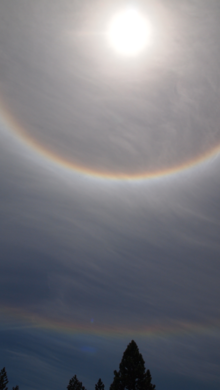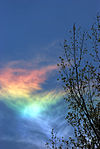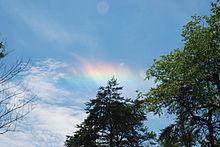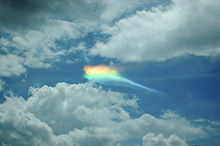- Circumhorizontal arc
-
A circumhorizontal arc is an optical phenomenon - an ice-halo formed by plate-shaped ice crystals in high level cirrus clouds.
The current accepted names are circumhorizon arc or lower symmetric 46° plate arc[1] The complete halo is a huge, multi-coloured band running parallel to the horizon with its center beneath the sun. The distance below the sun is twice as far as the common 22-degree halo. Red is the uppermost colour. Often, when the halo forming cloud is small or patchy, only fragments of the arc are seen.
How often a circumhorizontal arc is seen depends on the location and the latitude. In the United States it is a relatively common halo seen several times each summer in any one place. In contrast, it is rare to non-observable in northern Europe.
Formation of the halo requires that the sun be very high in the sky, at an elevation of 58° or more, and that the cirrus cloud or haze contains plate-shaped ice crystals. The sun's altitude determines the visibility of the halo; it is impossible to see at locations north of 55°N or south of 55°S (although a lunar circumhorizon arc might be visible). At other latitudes it is visible for a greater or lesser time around the summer solstice. Slots of visibility for different latitudes and locations can be looked up here. For example, in London, England the sun is only high enough for 140 hours between mid May and late July. Contrast that with Los Angeles with the sun higher than 58 degrees for 670 hours between late March and late September.
The halo is formed by sunlight entering horizontally-oriented flat hexagon ice crystals through a vertical side face and leaving through the near horizontal bottom face (plate thickness does not affect the formation of the halo). In principle, Parry oriented column crystals can also produce the arc, although this is rare.
The 90° inclination between the ray entrance and exit faces produce the well-separated spectral colours.
The arc has a considerable angular extent and is thus rarely complete. When only fragments of cirrus cloud are in the appropriate sky/sun position they can appear to shine with spectral colors.[2]
A circumhorizontal arc can be difficult to distinguish from an infralateral arc when the sun is high in the sky. The former is always parallel to the horizon whereas the latter curves upwards at its ends.[2]
-
Photographed in Coeur d'Alene, Idaho
-
Photographed in Ravenna, Michigan
-
Photographed in Hocking Hills, Ohio
See also
References
- ^ Tape, Walter and Moilanen, Jarmo - 'Atmospheric Halos & the search for angle x', American geophysical Union,2006 - pp196-7
- ^ a b Les Cowley. "Circumhorizon arc". Atmospheric Optics. http://www.atoptics.co.uk/halo/cha2.htm. Retrieved 2007-04-22.
External links
Categories:- Atmospheric optical phenomena
-
Wikimedia Foundation. 2010.





